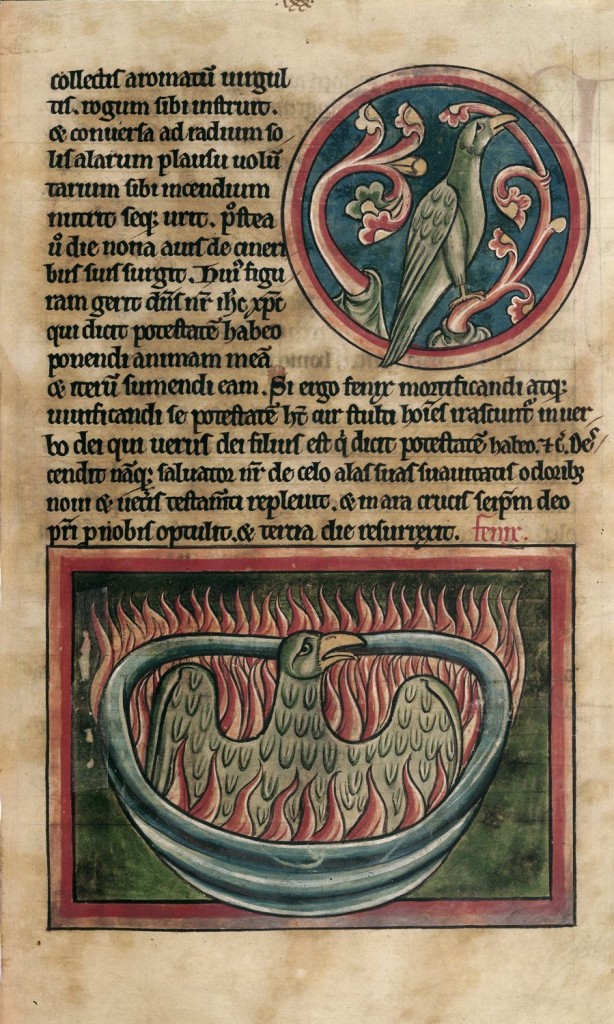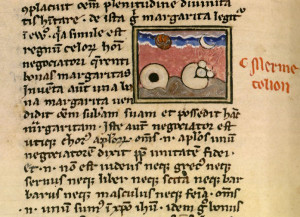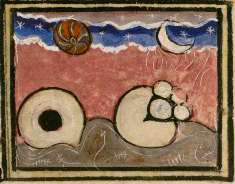Professor Diane Murphy
Cecco d’Ascoli’s Book of Beasts
The medieval bestiary, literally a “book of beasts,” is a collection of animal lore that combines observations about the natural world with moral lessons. Bestiaries form part of a literary tradition that can be traced back to earlier genres such as Aesop’s fables. The concept that nature provides us with models for ethical behavior was probably transmitted orally, however, through proverbs and stories told to children. In the Middle Ages, the descriptions of fauna, both real and mythical, were often rhymed and accompanied by whimsical illustrations that continue to fascinate audiences of all ages.
Manuscripts were expensive in the period during which they had to be painstakingly copied by hand. The popularity of bestiaries is attested by the fact that almost every noble family and religious institution in Europe possessed one in their private libraries. With the invention of the printing press in the fifteenth century, books could be mass produced, but they were still considered luxury items. Even a famous artist like Leonardo da Vinci could afford only a modest collection of approximately forty titles. The list for his library includes a reference to Cecco d’Ascoli, author of the Acerba, which contains a bestiary section that some scholars believe was used as the source for Da Vinci’s own version.
Ironically, neither Da Vinci nor anyone else should have owned a copy of the Acerba, which was banned by papal decree when Cecco was burned at the stake as a heretic in 1327. It seems likely that people in the late Middle Ages, like people today, were attracted by the “off limits” status of the book, which circulated widely in clandestine copies after the author’s death. Cecco’s reputation as a necromancer who disseminated the secrets of black magic to his students has little to do with the actual contents of the Acerba, but there are indications in the text that the astrologer may have prudently decided to exercise a bit of self-censorship while he was under arrest.
Some manuscripts of Cecco’s unfinished encyclopedic poem use the title L’Acerba Età, which can be translated as The Bitter Age. In fact, it’s tempting to interpret many of the messages contained in the book as references to the poet’s own state of mind while attempting to complete his work, knowing that time was running out. The samples from the bestiary included here contain poignant lines that evoke the anguish of a man facing an unjust death sentence ordered by the Inquisition. More information about the historical period during which Cecco lived, which was indeed a “bitter age,” can be found in the English translation available as a digital text through Capponi Editore.
Love is like the phoenix in this way:
when it feels that its vitality is waning,
it’s born again. Listen to this marvel!
The phoenix, found in eastern deserts,
will beat its wings against the heat
until the motion ignites hot flames.
Then, I tell you, it’s reduced to ashes.
But by means of the moon’s influence,
little by little the phoenix returns to life,
rising from the ashes to its former state.
There’s never more than one in the world,
yet its range expands throughout the East.
In these dark times, anyone facing death
at the hands of deluded, rapacious men
should light desire’s flame in his heart.
As he burns, he’ll sing a righteous song.
Defeating ignorance with fervent faith,
he’ll return to the world via Paradise.
The Tiger
The tiger runs as swiftly as an arrow,
somewhat like its cousin the panther.
It’s always worried about its young.
Hunters use mirrors to cast images
of the cubs, so that the parent tiger,
seeing the likeness, won’t chase them.
Gazing into the mirrors, it believes
that its cubs are safe; then the hunter
flees, quickly getting beyond reach.
When the tiger realizes that it’s been
fooled by shadows, its mind succumbs
to grief and it roars in pain and sorrow.
Thus our enemy the devil deceives us,
using the seductive mirror of illusion
as a trap to strip wisdom from our souls.
How frightening it is to me when I think
of how little time we have on this earth,
and how rapidly our lives can slip away.
The span of a human life flows like water,
and soon we must leave this world behind.
The Crocodile
The crocodile spends the winter in water
and the summer on land, growing rapidly.
Its worst enemy is a type of crested fish.
The upper jaw of the crocodile moves,
while the lower mandible remains still.
Females, in heat, bury eggs in the earth.
Crocodiles never emerge during winter,
but are revived by mild spring weather,
when young plants bolster their strength.
They’ll kill a man as soon as they see him,
but once he dies, the beast begins to cry,
seeming to mourn, with piteous sobbing.
Then, having wept, it chews and devours
the human flesh. If a serpent crawls into
its mouth while the crocodile is sleeping,
it destroys the enemy’s heart and entrails,
not stopping until it dies an agonizing death
that almost seems like an act of vengeance.
Hypocrites and devious men do this.
Their hearts delight in inflicting pain,
while their faces retain a merciful look.
Any little thing seems to make them cry.
They’re untrustworthy and malicious:
watch out, and don’t fall for their traps!
The Oyster
The oyster opens its shell completely
when the moon is full: seeing this,
the crab starts planning its next meal.
It places a stone or a branch inside,
so that the oyster loses its safe cover.
In this way, the crab traps its victim.
Similarly, a man who opens his mouth,
revealing his secrets to a false traitor,
will feel the wound deep in his heart.
Words can be a matter of life and death.
A wise man will always remain silent
in the midst of wicked acquaintances.
If you want to live long, remember:
you’ll never be damned for silence.
The Viper
The female viper is a poisonous snake
that bears her young with great effort
and dies painfully while giving birth.
Once pregnant, she kills her mate
and decapitates him with her teeth,
feeling her heart betrayed by love.
The young snakes are born by tearing
through her side, according to nature,
which rules the instincts of all beasts.
Because they’re full of venom, vipers
sleep in caverns during the cold season:
spring weather brings them out in force.
Their blind eyes can be cured with fennel.
Before engaging in the act of copulation,
the female viper regurgitates her venom;
as soon as her desire has been achieved,
she reabsorbs it and goes on her way,
since poison is essential to their lives.
Some men act this way when they confess,
regurgitating their sins and seeming contrite:
they don’t stop sinning in their hearts, though.
They aren’t truly repentant, even if it seems
they’ve changed, since they always return,
shamefaced, to their previous wicked ways.
*All images courtesy of the British Library, Catalog of Illuminated Manuscripts.
00
Diane Murphy earned her BA at Brown University and her doctorate at the University of Massachusetts/Amherst in Comparative Literature, with an emphasis on medieval studies. She is currently a Professor of Humanities at Unity College, where she has taught literature, composition and general education courses since 1997. For the past ten years, she has conducted research on Cecco d’Ascoli, author of the Acerba, and has recently published a full translation of the poem, available as a digital edition.

































